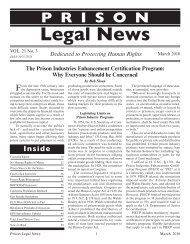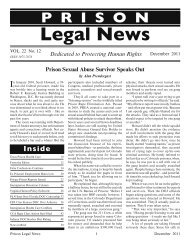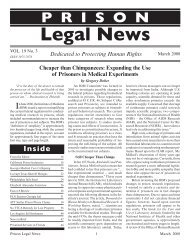From the Editor - Prison Legal News
From the Editor - Prison Legal News
From the Editor - Prison Legal News
Create successful ePaper yourself
Turn your PDF publications into a flip-book with our unique Google optimized e-Paper software.
Like o<strong>the</strong>r prison systems throughout<br />
<strong>the</strong> nation, Connecticut’s is<br />
reaching peak capacity. In <strong>the</strong> midst of<br />
dealing with overcrowding and parole<br />
issues, <strong>the</strong> Connecticut Department of<br />
Correction (CDOC) must also determine<br />
how to handle a growing number of prisoners<br />
with mental health issues.<br />
To readers of PLN, <strong>the</strong> increasing<br />
population of mentally ill offenders in<br />
America’s prisons is nothing new. Even<br />
prison guards recognize <strong>the</strong> difference<br />
between treating mental illness and warehousing<br />
mentally ill prisoners. “We’ve<br />
become society’s mental health provider,”<br />
said Steve Curran, a guard at CDOC’s<br />
Garner Correctional Institution (GCI)<br />
and Secretary of <strong>the</strong> American Federation<br />
of State, County and Municipal Employees<br />
Local 1565.<br />
After becoming CDOC’s Commissioner,<br />
Theresa C. Lantz designated GCI<br />
as a facility to house mentally ill prisoners.<br />
Currently about 450 of GCI’s 554<br />
prisoners are classified as having mental<br />
problems. Yet, Lantz has insisted that<br />
she is “... not running a mental health<br />
hospital.”<br />
Curran observed that guards regard<br />
mentally ill prisoners as prisoners first,<br />
while <strong>the</strong> nurses “are treating <strong>the</strong>m as<br />
clients and patients.” Recognizing that<br />
could pose a problem, Connecticut’s<br />
2006 General Assembly passed a bill that<br />
requires additional psychiatric training<br />
for guards.<br />
Most mentally ill people who land in<br />
prison are <strong>the</strong>re for minor offenses. “Everybody<br />
calls <strong>the</strong> police when someone<br />
becomes disruptive, and those people are<br />
often mentally ill,” said state Rep. Patricia<br />
Dillon. The co-chair of <strong>the</strong> legislature’s<br />
Judiciary Committee, Rep. Michael P.<br />
Lawlor, agreed.<br />
As a former prosecutor, Lawlor acknowledged<br />
that homeless citizens who<br />
trespass, urinate in public or cause o<strong>the</strong>r<br />
disturbances are often sent to prison.<br />
“Because <strong>the</strong>re seems to be no o<strong>the</strong>r options,<br />
<strong>the</strong>y end up being dumped in jail,”<br />
he said.<br />
Dillon and Lawlor are not alone<br />
among legislators on this issue. “I question<br />
whe<strong>the</strong>r we’re incarcerating <strong>the</strong> right people<br />
for <strong>the</strong> right reasons,” stated Deputy<br />
As Connecticut’s <strong>Prison</strong> Population Increases,<br />
So Does <strong>the</strong> Number of Imprisoned Mentally Ill<br />
by David M. Reutter<br />
House Majority Leader Toni Walker.<br />
The questions being raised by lawmakers<br />
are largely a result of <strong>the</strong> drain<br />
that mentally ill prisoners are placing<br />
on <strong>the</strong> state’s budget. With <strong>the</strong> recent<br />
release of a CDOC report that found 20<br />
percent of <strong>the</strong> state’s prison population<br />
was mentally ill, <strong>the</strong> expense of caring<br />
for those prisoners has become a serious<br />
fiscal issue.<br />
The cost of providing medical care<br />
for prisoners has increased 22 percent<br />
in recent years. Consequently, <strong>the</strong> state’s<br />
prison medical budget ballooned from<br />
$77.4 million in 2003-04 to almost $100<br />
million for 2007-08. CDOC’s population<br />
has remained relatively stable over<br />
that time period. According to Majority<br />
Leader Walker, care for mentally ill prisoners<br />
has significantly contributed to <strong>the</strong><br />
cost increase.<br />
Because counselor-based treatment<br />
of <strong>the</strong> mentally ill is more expensive than<br />
pharmaceutical treatment, prison officials<br />
prefer to administer psychotropic drugs.<br />
Such drugs have <strong>the</strong> effect of making<br />
mentally ill prisoners feel in a stupor, which<br />
makes <strong>the</strong>m more compliant; thus, guards<br />
prefer this method of treatment, too. The<br />
financial result is that CDOC’s most recent<br />
$9.6 million increase in prisoner healthcare<br />
costs comes in part from a 7 percent rise in<br />
spending for pharmaceuticals.<br />
What to do with or about <strong>the</strong> mentally<br />
ill has become a major issue due to<br />
a September 24, 2007 temporary ban on<br />
parole for prisoners convicted of violent<br />
offences, which has put a squeeze on<br />
<strong>the</strong> prison population. That squeeze has<br />
about 300 CDOC prisoners sleeping on<br />
beds in gym areas because <strong>the</strong>re are not<br />
enough cells.<br />
The parole restrictions were enacted<br />
by Gov. M. Jodi Rell following two violent<br />
incidents involving parolees. The first occurred<br />
when two parolees were arrested for<br />
a July 23, 2007 home invasion and triple<br />
murder in Cheshire. The second was when<br />
ano<strong>the</strong>r parolee was shot and wounded by<br />
New York police as he exited a vehicle he<br />
had carjacked at knife point.<br />
“We will ensure that violent offenders<br />
who pose a risk to society stay behind bars<br />
while continuing to help nonviolent offenders<br />
make <strong>the</strong> most effective transition<br />
possible back to society,” said Governor<br />
Rell.<br />
Some legislators disagreed. They felt<br />
that releasing certain nonviolent prisoners,<br />
such as drug addicts, would be freeing<br />
<strong>the</strong> ones who were more likely to reoffend.<br />
“You are potentially creating a lot more<br />
problems here,” said Rep. Lawlor.<br />
Under Connecticut law, prisoners<br />
who commit violent crimes must complete<br />
85 percent of <strong>the</strong>ir sentences, while<br />
nonviolent offenders need only complete<br />
about half of <strong>the</strong>ir prison terms before<br />
<strong>the</strong>y can obtain parole. Despite having<br />
already served longer sentences, Gov. Rell<br />
ordered state officials to review <strong>the</strong> files<br />
of 600 to 800 violent offenders who are<br />
currently on parole.<br />
“If we identify anyone in this review<br />
who has failed to follow <strong>the</strong> terms of <strong>the</strong>ir<br />
release – or if anyone currently on parole<br />
fails to do so in <strong>the</strong> future – we will revoke<br />
<strong>the</strong>ir parole and return <strong>the</strong>m to prison to<br />
serve <strong>the</strong> balance of <strong>the</strong>ir sentence,” she<br />
said.<br />
The CDOC’s population has increased<br />
from 18,869 prisoners in July<br />
2007 to 19,655 since <strong>the</strong> ban on parole for<br />
violent offenders was implemented last<br />
September. The state’s prison system is<br />
only designed to hold about 17,600. The<br />
overcrowding and inherent increase in<br />
<strong>the</strong> prison population that will result due<br />
to <strong>the</strong> parole restrictions has lawmakers<br />
concerned.<br />
“It’s pretty clear <strong>the</strong> governor did not<br />
do a lot of checking before she announced<br />
her policy,” Lawlor said. “It’s not clear<br />
exactly what <strong>the</strong>ir plan is to keep a lid on<br />
<strong>the</strong> [prison] population.”<br />
Governor Rell declined an invitation<br />
to testify before <strong>the</strong> legislature to detail<br />
her plans. CDOC Commissioner Theresa<br />
C. Lantz appeared in her stead. Prior<br />
to Gov. Rell’s new parole policy, Lantz<br />
had said <strong>the</strong> prison system was “full.”<br />
Yet she claimed <strong>the</strong>re was no maximum<br />
population, as <strong>the</strong> system could adjust<br />
to increases without more money, a new<br />
prison or added resources.<br />
“Is <strong>the</strong>re ever a limit as to how many<br />
prisoners you can fit into a building?”<br />
asked Rep. Gerald Fox, vice chairman of<br />
<strong>the</strong> House Judiciary Committee.<br />
“As of right now, we have enough bed<br />
April 2008<br />
20<br />
<strong>Prison</strong> <strong>Legal</strong> <strong>News</strong>

















